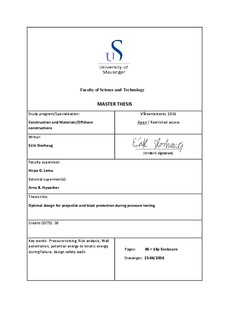| dc.contributor.author | Storhaug, Eirik | |
| dc.date.accessioned | 2016-09-29T07:01:19Z | |
| dc.date.available | 2016-09-29T07:01:19Z | |
| dc.date.issued | 2016-06-15 | |
| dc.identifier.uri | http://hdl.handle.net/11250/2411600 | |
| dc.description | Master's thesis in Offshore structural engineering | nb_NO |
| dc.description.abstract | The thesis identifies the main hazards in hydrostatic pressure testing as pressure wave, water jet, burst of water hose, fragment and projectile discharge as well as ejection of plug or end section.
A test, where a pressurized vessel ejected a projectile, was conducted as part of the thesis. The aim of this test was to find the relationship between potential energy inside pressure vessel and kinetic energy in a discharged projectile. The results showed that the Baker formula together with the elastic energy of the expanded pipe, gave a good representation of the kinetic energy.
Based on the results from the test, a risk analysis concerning pressure testing at TDW is made. The analysis involves hazards assessment through calculations. Existing safety walls are analyzed and mediating measures to lower the risk to an acceptable level are proposed.
An assessment of the safety barriers concluded that only fragments and projectiles or plug and end section could breach the first two safety barriers. Fragments and projectiles will most likely perforate the safety walls, while a plug or end section will probably exceed the shear and moment capacities in the safety wall. The pressure wave, water jet and burst of water hose would most likely be confined by the first barrier.
For the vessels and pressure tests considered in this paper, the thesis suggests three safety barriers to reduce the risk to an acceptable level. First safety barrier should be an existing safety wall. The second safety barrier is a closed off area between the first and third safety barrier. The third and last safety barrier is either an existing safety wall or a steel safety wall.
To improve the existing safety wall, a steel plate should be attached behind the wall. The steel plate will increase the shear strength of the wall as well as preventing sections of the wall to collapse during perforation of projectile.
The calculations indicate that either a steel safety wall or the existing safety wall can be perforated by smaller projectiles. Because of small projectile diameter and large velocity, the wall at impact location will undergo a local deformation. This will lead to smaller plastic deformation and less energy is absorbed by the wall.
Large projectile will create a global effect on the walls. These projectiles will not perforate the wall, but instead apply large axial and moment forces to the wall. To improve the walls resistance against axial and bending loads, the safety walls should be bolted to the floor. | nb_NO |
| dc.language.iso | eng | nb_NO |
| dc.publisher | University of Stavanger, Norway | nb_NO |
| dc.relation.ispartofseries | Masteroppgave/UIS-TN-IKM/2016; | |
| dc.rights | Navngivelse-IngenBearbeidelse 3.0 Norge | * |
| dc.rights.uri | http://creativecommons.org/licenses/by-nd/3.0/no/ | * |
| dc.subject | offshorekonstruksjoner | nb_NO |
| dc.subject | offshore konstruksjonsteknikk | nb_NO |
| dc.subject | pressure testing | nb_NO |
| dc.subject | risk analysis | nb_NO |
| dc.subject | wall penetration | nb_NO |
| dc.subject | potential energy to kinetic energy during failure | nb_NO |
| dc.subject | design safety walls | nb_NO |
| dc.title | Optimal design for projectile and blast protection during pressure testing | nb_NO |
| dc.type | Master thesis | nb_NO |
| dc.subject.nsi | VDP::Technology: 500::Marine technology: 580::Offshore technology: 581 | nb_NO |

